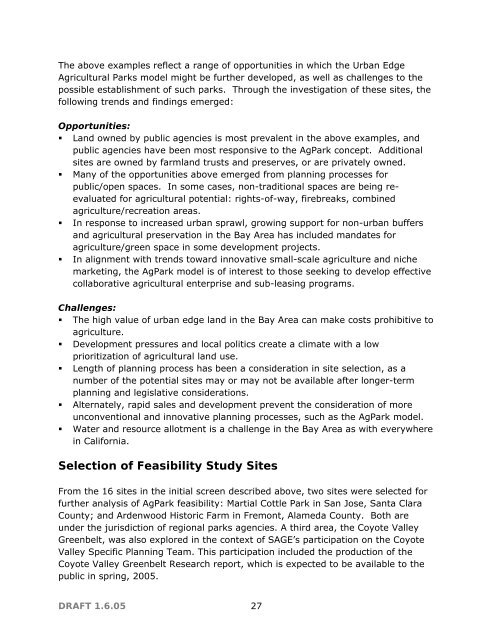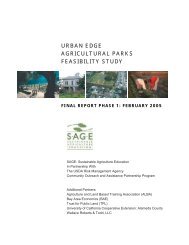A Feasibility Study for Urban Edge Agricultural Parks - SAGE
A Feasibility Study for Urban Edge Agricultural Parks - SAGE
A Feasibility Study for Urban Edge Agricultural Parks - SAGE
Create successful ePaper yourself
Turn your PDF publications into a flip-book with our unique Google optimized e-Paper software.
The above examples reflect a range of opportunities in which the <strong>Urban</strong> <strong>Edge</strong><strong>Agricultural</strong> <strong>Parks</strong> model might be further developed, as well as challenges to thepossible establishment of such parks. Through the investigation of these sites, thefollowing trends and findings emerged:Opportunities:• Land owned by public agencies is most prevalent in the above examples, andpublic agencies have been most responsive to the AgPark concept. Additionalsites are owned by farmland trusts and preserves, or are privately owned.• Many of the opportunities above emerged from planning processes <strong>for</strong>public/open spaces. In some cases, non-traditional spaces are being reevaluated<strong>for</strong> agricultural potential: rights-of-way, firebreaks, combinedagriculture/recreation areas.• In response to increased urban sprawl, growing support <strong>for</strong> non-urban buffersand agricultural preservation in the Bay Area has included mandates <strong>for</strong>agriculture/green space in some development projects.• In alignment with trends toward innovative small-scale agriculture and nichemarketing, the AgPark model is of interest to those seeking to develop effectivecollaborative agricultural enterprise and sub-leasing programs.Challenges:• The high value of urban edge land in the Bay Area can make costs prohibitive toagriculture.• Development pressures and local politics create a climate with a lowprioritization of agricultural land use.• Length of planning process has been a consideration in site selection, as anumber of the potential sites may or may not be available after longer-termplanning and legislative considerations.• Alternately, rapid sales and development prevent the consideration of moreunconventional and innovative planning processes, such as the AgPark model.• Water and resource allotment is a challenge in the Bay Area as with everywherein Cali<strong>for</strong>nia.Selection of <strong>Feasibility</strong> <strong>Study</strong> SitesFrom the 16 sites in the initial screen described above, two sites were selected <strong>for</strong>further analysis of AgPark feasibility: Martial Cottle Park in San Jose, Santa ClaraCounty; and Ardenwood Historic Farm in Fremont, Alameda County. Both areunder the jurisdiction of regional parks agencies. A third area, the Coyote ValleyGreenbelt, was also explored in the context of <strong>SAGE</strong>’s participation on the CoyoteValley Specific Planning Team. This participation included the production of theCoyote Valley Greenbelt Research report, which is expected to be available to thepublic in spring, 2005.DRAFT 1.6.05 27





